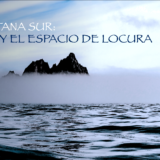
I don’t think you can find a better, more iconic image for Science Fiction in general that the spaceship, or, for an earlier era, the rocketship.
Indeed, the first and most recognizable award for the field is a rocketship, created for the Hugo Awards back in 1953, that although slightly changed over the years remains recognizably a rocket.

 When the Science Fiction League was announced in 1934, its logo also featured a rocketship. In fact, many early fans were amateur rocketeers (an experimental mail rocket blowing up pretty much ended that); library book stickers have featured a rocket and planet design for decades.
When the Science Fiction League was announced in 1934, its logo also featured a rocketship. In fact, many early fans were amateur rocketeers (an experimental mail rocket blowing up pretty much ended that); library book stickers have featured a rocket and planet design for decades.
It’s been pretty much the go-to symbol for the genre and, although it has evolved with designs immortalized in film and on TV (Star Trek’s Enterprise, Star Wars Millennium Falcon) the most common and familiar form is of a gently curved, cylindrical form with three or four fins and or landing legs attached. Such as the rendering that appears on one of the earliest Amazing Stories covers from our resurrection of the magazine:

That particular rocketship is actually based on one created by SF artist Morris Scott Dollens (1920-1994) and, at least in my own estimation, is about as an iconic rocketship design as iconics can get. It’s got that ogive shape, three fins, three landing struts and that overall fat cylinder shape.
Dollens (who you can learn more about here and here, and here you can find links to examples of his artwork) began with illustrations for fanzines, eventually worked his way to professional illustration for magazine and book covers (many in foreign markets) and also created models which he photographed as a storyboard for a film that was never made called Dream of the Stars which can be found at the University of Riverside, California collection, along with hundreds of other slides of his individual works.
But that’s not why we’re here today. We’re here because one of Dollen’s rocketship designs was included in many, many of his illustrations – the same design, that found there way onto the covers of a wide-range of magazines and books.
I strongly suspect that it is perhaps the most well-traveled Science Fiction Rocketship ever created – not in terms of volume (that probably goes to one of the ships featured in film and TV shows), but to the distance of its travels. From Altair to Zibal, I think its visited them all.
Here’s a gallery of the covers of books and magazines that have featured the “Dollen’s Rocket” over the years, as well as a few alternative (or perhaps “evolutions”) of that design:
I think what fascinates me the most is that, over time, through many different exposures in many different places, we acquire a vast amount of detail about this one ship (and perhaps its cousins or future generations); we learn its scale, that it launches from a gantry, but can also launch from anywhere; we see some of its equipment, that it’s boarded by ladder, the fact that it may have auxiliary rockets – and yet, it remains constant, and almost always the same color.
I’ve included a few of his other illustrations to demonstrate that he could draw more than that one rocket, and that he could appear in a wide variety of markets.
Bringing this home, that rocket has appeared on more individual magazine covers than any other: from the Science Fiction Advertiser, the Fantasy Advertiser, the German magazines Utopia and Orbit and, in alphabetical order – Fantastic, Gamma, Spaceway and Venture.
It’s had a pretty good run. I like to think it’s still out there.
(I think it should also probably be noted that Tintin’s moon rocket didn’t appear until 1953. They are very similar to Dollens’, but then, so are most cylindrical, tripedal rocketships.)








































Recent Comments